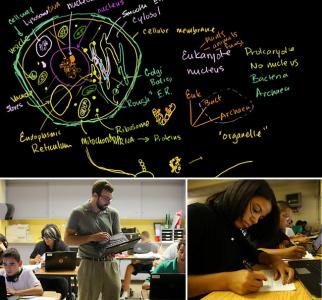Digitalizing Childhood Ed: Various Approaches

A friend recently told me an anecdote about her young son. Before I give you the story, I should probably relay some background information. My friend and her husband are both Berkeley-educated Bay Area yuppies. They enjoy their gadgets, and their household is stocked with technology. It is not, I imagine, uncommon to find them playing with their iPads, iPhones, Kindles, etc. in the child's presence.
As it turns out, their child has taken notice of these interactive, touch-screen toys. Growing up surrounded by adults on iPhones and tablets, it's hard to imagine he wouldn't. According to my friend, her son has started swiping at pictures on television, in magazines, and in books the way she swipes the screen of her iPad.
Though my friends shrug off this "monkey see, monkey do" behavior as humorous and unimportant, I can't help but sense that, after much time spent watching mommy and daddy, he anticipates images he encounters have some level of interactivity. And, given the direction tech is going, shouldn't this be the case? Shouldn't these innovations in the presentation and structuring of information be made available to children?
Four entries from the last several days deal with this issue inasmuch as it relates to new media and children's education. On Friday, 2.December, McGraw-Hill announced the McGraw-Hill Education's Networks™, "a groundbreaking multimedia social studies learning system that brings history to life for middle and high school students...[by combining] engaging print and digital resources to help students discover and learn essential social studies content in world history, U.S. history and civics."
That same day, MindShift, a blog on technology and education, ran a post, Blowing Out the Digital Book as We Know It, in which the author highlights Inkling.com's approach to digital publishing--one that attempts to produce books for the numerous capabilities of e-readers instead of simply digitizing the printed page. In the entry, the author notes, "Though most of the titles under Inkling’s belt are geared for higher education, MacInnis [Inkling's founder and CEO] sees the K-12 market as ripe for the medium. 'We fully expect that Inkling will be in the K-12 world,' he said. 'It’s already in use in that space, and we plan to make ourselves known to that audience more aggressively.'
On Monday, 5.December, MindShift published another blog entry, Will Online Education Expand in California?, discusses issues surrounding "a statewide ballot initiative [PDF] that would give students unrestricted access to publicly funded courses – wherever they are." The proposal would require districts and county offices to make available to all students the courses needed for admission to the state’s universities. Known as A-G requirements at the University of California and California State University, these could be offered at a student’s school or district of residence or any other publicly funded school, and they could be classroom-based, online or a blended model of the two. A recent analysis [PDF] by UCLA's Institute for Democracy, Education and Access indicates more than a quarter of public high schools in California offered too few A-G courses for all students to take them in 2007-08.
One final article, also from Monday, 5.December, appeared in the New York Times's Technology section. Titled "Online Learning, Personalized," the article profiles attempts by Salman Khan's Khan Academy, a collection of math and science instructional videos on YouTube, to move into the classroom environment. According to the article, "What makes Mr. Khan’s venture stand out is that the lessons and software tools are entirely free — available to anyone with access to a reasonably fast Internet connection."
All of these stories circle the same concern: bringing digital technology into childhood ed. Some premise this concern on helping children meet demanding pre-college requirements. Others premise this concern on building better, more interactive tools for student learning. What becomes obvious upon reading these articles, however, is a critical concern for what is best for the children and what is best for the communities from which they come. McGraw-Hill has, in the past, notably profited from shifts in educational policy. Congress, under the strong urging of George W. Bush, passed the No Child Left Behind Act of 2001. This act requires states to develop tests to assess basic skills of all students in certain grades, if those states are to receive federal funding for schools. Controversially, Barbara Bush had sat on McGraw-Hills's advisory board before the Act's passage, and, even more controversially, McGraw-Hill profited greatly from the 2001 Congressional act.
Speaking of the California initiative, John Affeldt, managing attorney for Public Advocates, which is representing organizations and families challenging the constitutionality of California’s school funding system, opines, “It seems at first blush to be more about an online provider’s bill of rights to get public money to provide online courses than an initiative to make sure we have equitable access to education for all kids."
What makes the Khan Academy model so novel is its cost. Rather than ask schools to shoulder the burden of these digital learning tools, Khan's academy operates off more than $16.5 million from technology donors, including Bill Gates, Google, the Silicon Valley Community Foundation and the O’Sullivan Foundation. If the digital is a promise of greater accessibility and lower costs, then this appears to be a wonderful instantiation of its promise.
It's far too early to tell how digital media technology will be installed into the classroom environment. This is still an open game. But, as we can clearly see from the four examples shown, it is also a very high stakes one. It deals with millions to billions of dollars of government money, the education of children, and children's indoctrination into coded relationships with digital media. We don't know what direction things will go, but there is a large difference between the impetus motivating Khan Academy and that which motivates McGraw-Hill.
Keep an eye on how these initiatives develop.